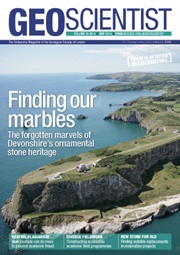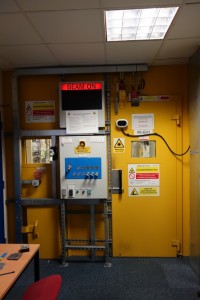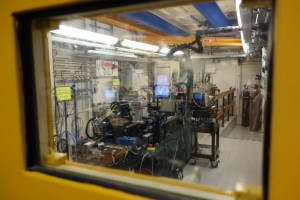Stuart Black has highlighted 2 articles in the recent edition of Geoscientist (May 2015). Firstly, the Editorial by Ted Nield where he reflects on diversity in relation to his graduation group photograph (from 1977) – https://www.geolsoc.org.uk/Geoscientist/May-2015/Enabled-bodies, and secondly, an article by Alison Stokes (Plymouth University) and Christopher Aitchison (University of Cincinnati) examining strategies for providing greater opportunities for students with disabilities to participate in geoscience fieldwork – https://www.geolsoc.org.uk/Geoscientist/May-2015/Getting-out-more
Tag Archives: Stuart Black
Chasing volcanic eruptions in stalagmites – The beam is on
Volcanic ‘super eruptions’ have had potentially devastating effects on human societies through their influence on global climate. The “year without summer” following the Tambora eruption in 1815, for instance, led to widespread famines in Europe and North America, and the very bad summer of 1816 inspired Mary Shelley to write the novel Frankenstein during her rainy holidays in Switzerland. Ancient cities such as Pompeii in Italy and Akrotiri on the island of Santorini were buried by volcanic eruptions. It is also believed that the Toba super eruption at around 74,500 years before present led to a substantial reduction in the human population to only a few thousand individuals. Finally, I was even personally affected by the eruption of Evjafjallajökull in 2010 when all flights to Europe were cancelled and I was stranded in Saudi Arabia. This event might explain my personal interest in the nature and timing of volcanic eruptions.
Reconstructing volcanic activity is not an easy task. To date, ice cores, lake, and marine sediments have all been used as primary sources of information for these eruptions. Unfortunately many of these archives are both poorly dated, with low chronological resolution, and have limitations on the exact type of past climate information that is recorded. Results of our pilot studies suggest that variations in sulphur, bromine and arsenic in precisely-dated stalagmites can be used to trace regional volcanic activity, such as the famous Minoan eruption of Thera at around 1621 BC. To trace volcanic eruptions in stalagmites from Turkey and China, we performed new measurements at the Diamond Light Source near Reading in April this year.
Performing these measurements at Diamond is a truly unforgettable experience as the scale of this machine is truly mind-blowing, particularly in comparison to our labs here in Reading. For the technical freaks among us, the Diamond Light Source generates a light 10 billion times brighter that the sun by accelerating electrons to near light speed (http://www.diamond.ac.uk/Home/About/How-Diamond-Works.html). This bright beam is then directed off into laboratories also known as “beamlines” were the light is then used to study all kinds of materials, including stalagmite calcite. For those not interested in technical details, this is a gigantic microscope that allows you to study molecules and even atoms.

Inside the Diamond Light Source. The yellow boxes are individual laboratories known as beamlines (D. Fleitmann).
The SAGES team, consisting of PhD-student Sarah Jones, Dr. Stuart Black and myself, started our experiments on a Friday morning using beamline I-18. After mounting one of our samples onto a sample carrier, we entered the so-called experimental hutch (see picture) to set up the experiments. To start the measurements we had to leave the hutch and close the main door.
In the control cabin, (see picture) we defined the sampling track to measure trace elements at a resolution of only 2 micrometres over a distance of 3 centimetres, the entire scan took approximately 15 hours. During this time at least one member of the team was present to control the measurements. After three exhausting days with very little sleep, we managed to complete all of our experiments successfully, and to conduct several hundred thousand measurements. The following numbers may give you an idea about the scale of our experiments. We’ve been using the 500 meter long Diamond Light Source to generate a beam of only 2.5 micrometres (at least for our experimental set up). A 10 cm long stalagmite from China covering almost 3000 years was measured in just 2 days and a weekly resolution could be achieved. The weight of the stalagmite was around 0.500 kg and we were able to detect and date the Toba super eruption, which released approximately 7 x 1015 kg of magma. We’ve been able to detect and date approximately 30 volcanic eruptions in just 3 days and nights. I had only 6 hours of sleep during these three days and consumed approximately 40 cups of coffee to stay awake. Why did we do this? Well, to develop a very innovative approach to date major volcanic eruptions and to publish at least 3 articles in peer-reviewed international journals. I can’t wait to go back to run more samples!

Sarah Jones and Senior Support Scientist Dr. Tina Geraki in the control cabin performing the trace element measurements.
 A bit about today’s blogger: Dominik Fleitmann – Professor of Palaeoclimatology and Archaeology
A bit about today’s blogger: Dominik Fleitmann – Professor of Palaeoclimatology and Archaeology
As a paleoclimatologist I am working on a variety of climate archives, including speleothems (stalagmites, flowstones), lacustrine sediments, spring carbonates and corals. The ultimate goal of my research is to construct precisely-dated and highly-resolved time series that provide new insights into climatic and environmental processes over a variety of timescales, ranging from seasonal to glacial/interglacial cycles. One particular aspect of my current and future research is to develop Holocene records that can provide information on climatic and environmental changes in unprecedented detail. Such records are crucial for interpreting archaeological findings and societal changes. It is therefore not surprising that my research interests and experience span a wide range of topics from paleoclimate, geochemistry, meteorology to archaeology and climate modelling. Because of the strong interdisciplinary nature of my research, I have developed a rich network of national and international collaborations.
- Holocene climate variability in Europe and the Middle East
- Impact of abrupt climatic events on societies
- Timing and nature of abrupt climatic events (e.g. Dansgaard-Oeschger events)
- Climate and Human dispersal (Out of Africa II)







